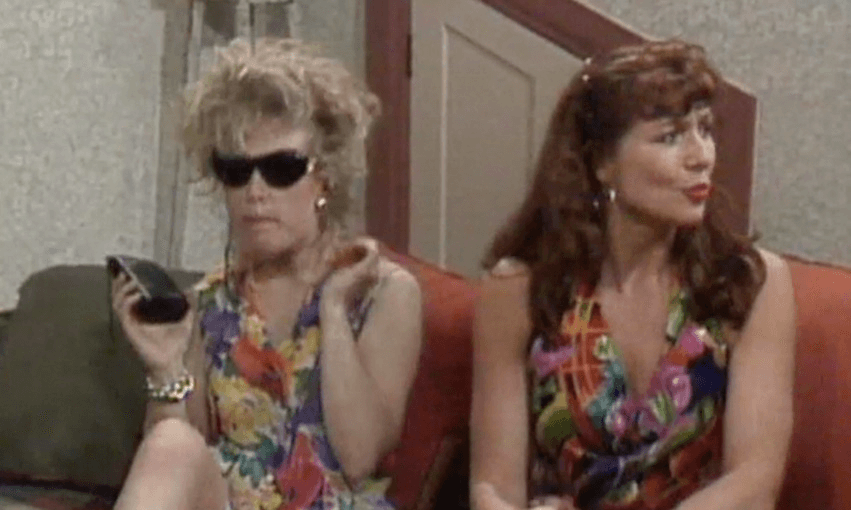Wikipedia has it on its list of the worst sitcoms of all time. But how bad is it? Sam Brooks watched the first episode of Melody Rules to find out if the notorious Kiwi comedy has been unfairly maligned.
The answer is yes, but also no.
For those of you who are not in the know about a fairly obscure but high profile failure in New Zealand television history, Melody Rules is our nation’s first attempt at a sitcom, way back in 1993. It was given $1.2 million by NZ on Air (which translates to about thirty million dollars in today’s money, if my calculations are correct) and came after an American writer was brought over to workshop ideas with New Zealand writers about how to write an American-style sitcom. I can only imagine he focused his lessons on wacky hijinks, easily resolvable misunderstandings that can be stretched out to a bloated 22 minutes, and how to match up C+ men with A- women.
The result was a show about Melody, a twenty/thirty-something woman lives at home with her two siblings and absentee mother. She’s just about to move out when, surprise sitcom twist, her mother says she’s never coming home. Looks like they’re all living under Melody’s rules now, hence the name of the show.
Despite running for 44 episodes, which is apparently how long even unsuccessful shows ran back in the ’90s, Melody Rules was deemed a commercial and critical failure. But is it that bad?
Honestly, no. Most of what is bad about Melody Rules comes from the fact that it’s a ‘three camera sitcom’ (we’ll come back to those quote marks later) from the 90s. This might surprise you, but not a lot of sitcoms from that era actually hold up! While funny is always funny, comedy ages like a pack-a-day smoker – it feels good at the time but in the cold light of day it goes down like blunt daggers. The three-camera style has aged especially poorly, with its canned laughter/live studio audience (whichever you feel like believing at the time) and its cheap looking sets. If you’re not Friends, Seinfeld or Frasier, which ran for as many season as they did because they were actually good and beloved, chances are a traditional-style sitcom from the 90s won’t look so good now.
And it’s hardly the biggest call to say that Melody Rules is no Friends. For one, it’s not actually a proper three-camera sitcom – it’s a show with a lot of strange camera angles and insert close-ups, like they didn’t trust audiences to actually understand what was being talked about. Literally the second shot of the show is a close-up of Melody’s dress getting stuck on the door (she’s so wacky!) just to make sure that we actually get what’s happening.
It’s staged and blocked less like a TV show and more like a university play, with a lot of movement that means that the editing isn’t cutting between jokes, it’s cutting between movement. An analogy: imagine if instead of cutting a sausage into small circular chunks, you cut it into very thin cylindrical chunks to eat. It’s the same product; it’s just a lot harder to eat.
Another thing that makes Melody Rules hard to swallow, and I can imagine critics being particularly savage about it 25 years ago, is the acting. Not because it’s bad, it’s just incredibly ill-suited for the genre. Belinda Todd, who came from a broadcasting background, is a naturally big and charismatic presence, but is constantly pushing her performance into very big places. The end result is a character who comes across like a washed-up vaudeville performer. The other actors fare a bit better – especially Jodie Rimmer, whose delivery manages to make some average jokes pretty damn funny – but it’s obvious that many of them are performing in a style they’re not comfortable with.
Which is understandable! Acting is a craft, and it has to be adjusted for every medium. What you do on stage is very different from what you’d do onscreen, and the three-camera sitcom is a beast between the two – it combines the live feeling of theatre with the intimacy of TV. If you go too big, you’ll knock dinner off the laps of the people watching at home. If you go too small, you’ll look wooden. So to blame a group of actors for not adjusting to a form that had never been done in this country before is pretty unkind.
And it’s especially unkind when the actors are working with jokes that were tired in the 90s, and are well and truly cremated and spread out to sea by 2018. It’s a bunch of tired tropes (the rebel sister! the dumb brother! the ‘slutty’ best friend!) delivering out jokes that have been workshopped to death. It’s hard to blame the writing, but not blaming it doesn’t mean it’s good.
So is Melody Rules as bad as all that? Yes, because it’s a sitcom from the 90s, made by a team that were not hugely experienced in this form, for a country that was not ready for it. And no, because it’s just another bad sitcom. We’ve all been too lazy to change the channel in front of a sitcom that we don’t quite laugh at, but smile at, and Melody Rules is no worse (but certainly no better) than that.
There is, however a scene where the neighbourhood kid (played by Elliot O’Donnell, who would later become popular and legit awesome street artist Askew One) helps his friend talk to girls by putting a bikini on a wicker chair. So maybe it is actually that bad, you guys.
You can watch Melody Rules for yourself on NZ on Screen right here.



